Wind Speed Analysis of Hurricane Sandy
Abstract
:1. Introduction
2. Materials and Methods
2.1. Database Description
2.2. Statistics
2.3. The Laplace Distribution
2.4. Recirculation Factor
3. Results
3.1. Database Analysis
3.2. Analysis of Hurricane Sandy
3.2.1. Wind Speed Analysis
3.2.2. Surface Analysis
3.2.3. Recirculation Factor Analysis
4. Discussion
4.1. Database Analysis
4.2. Wind Speed
4.3. Radius
4.4. Air Parcel Trajectories
5. Conclusions
Author Contributions
Funding
Institutional Review Board Statement
Informed Consent Statement
Data Availability Statement
Conflicts of Interest
References
- Depietri, Y.; McPhearson, T. Changing urban risk: 140 years of climatic hazards in New York City. Clim. Chang. 2018, 148, 95–108. [Google Scholar] [CrossRef] [Green Version]
- Crowley, R.; Robeck, C.; Dompe, P. A three-dimensional computational analysis of bridges subjected to monochromatic wave attack. J. Fluids Struct. 2018, 79, 76–93. [Google Scholar] [CrossRef]
- Gallucci, M. Rebuilding Puerto Rico’s Grid: Eight months after Hurricane Maria, electricity is nearly restored—But that’s just the beginning. IEEE Spectr. 2018, 55, 30–38. [Google Scholar] [CrossRef]
- Hallowell, S.T.; Myers, A.T.; Arwade, S.R.; Pang, W.; Rawal, P.; Hines, E.M.; Hajjar, J.F.; Qiao, C.; Valamanesh, V.; Wei, K.; et al. Hurricane risk assessment of offshore wind turbines. Renew. Energy 2018, 125, 234–249. [Google Scholar] [CrossRef]
- He, Y.; Han, X.; Li, Q.; Zhu, H.; He, Y. Monitoring of wind effects on 600 m high Ping-An Finance Center during Typhoon Haima. Eng. Struct. 2018, 167, 308–326. [Google Scholar] [CrossRef]
- Murià-Vila, D.; Jaimes, M.A.; Pozos-Estrada, A.; López, A.; Reinoso, E.; Chávez, M.M.; Peña, F.; Sánchez-Sesma, J.; Lopez, O. Effects of hurricane Odile on the infrastructure of Baja California Sur, Mexico. Nat. Hazards 2018, 91, 963–981. [Google Scholar] [CrossRef]
- Huang, P.; Tao, L.; Gu, M.; Quan, Y. Experimental study of wind loads on gable roofs of low-rise buildings with overhangs. Front. Struct. Civ. Eng. 2018, 12, 300–317. [Google Scholar] [CrossRef]
- Monteclaro, H.; Quinitio, G.; Moscoso, A.D.; Napata, R.; Liberty, E.; Anraku, K.; Watanabe, K.; Ishikawa, S. Impacts of Typhoon Haiyan on Philippine capture fisheries and implications to fisheries management. Ocean Coast. Manag. 2018, 158, 128–133. [Google Scholar] [CrossRef]
- Schwartz, R.M.; Tuminello, S.; Kerath, S.M.; Rios, J.; Lieberman-Cribbin, W.; Taioli, E. Preliminary Assessment of Hurricane Harvey Exposures and Mental Health Impact. Int. J. Environ. Res. Public Health 2018, 15, 974. [Google Scholar] [CrossRef] [Green Version]
- Holland, G. A Revised Hurricane Pressure–Wind Model. Mon. Weather Rev. 2008, 136, 3432–3445. [Google Scholar] [CrossRef] [Green Version]
- Lin, L.; Weng, F. Estimation of Hurricane Maximum Wind Speed Using Temperature Anomaly Derived From Advanced Technology Microwave Sounder. IEEE Geosci. Remote Sens. Lett. 2018, 15, 639–643. [Google Scholar] [CrossRef]
- Liu, Y.; Chen, D.; Li, S.; Chan, P. Revised power-law model to estimate the vertical variations of extreme wind speeds in China coastal regions. J. Wind. Eng. Ind. Aerodyn. 2018, 173, 227–240. [Google Scholar] [CrossRef]
- Kendall, W.S. Barycentres and hurricane trajectories. In Geometry Driven Statistics; Dryden, I.L., Kent, J.T., Eds.; John Wiley & Sons: Hoboken, NJ, USA, 2015; pp. 146–160. [Google Scholar] [CrossRef] [Green Version]
- Mok, D.K.H.; Chan, J.C.L.; Chan, K.T.F. A 31-year climatology of tropical cyclone size from the NCEP Climate Forecast System Reanalysis. Int. J. Clim. 2018, 38, e796–e806. [Google Scholar] [CrossRef]
- Meyer, G.; Vitiello, G. On the molecular dynamics in the hurricane interactions with its environment. Phys. Lett. A 2018, 382, 1441–1448. [Google Scholar] [CrossRef] [Green Version]
- Hosseini, S.R.; Scaioni, M.; Marani, M. On the influence of global warming on atlantic hurricane frequency. Int. Arch. Photogramm. Remote Sens. Spat. Inf. Sci. ISPRS Arch. 2018, 42, 527–532. [Google Scholar] [CrossRef] [Green Version]
- Kossin, J.P. A global slowdown of tropical-cyclone translation speed. Nature 2018, 558, 104–107. [Google Scholar] [CrossRef]
- Rojo-Garibaldi, B.; Salas-De-León, D.A.; Sánchez, N.L.; Gómez, M.A.M. Hurricanes in the Gulf of Mexico and the Caribbean Sea and their relationship with sunspots. J. Atmos. Sol. Terr. Phys. 2016, 148, 48–52. [Google Scholar] [CrossRef]
- Fontenot, A.T.; El-Askary, H.M.; Garay, M.J.; Campbell, J.R.; Kalashnikova, O.V. Characterizing the Impact of Aerosols on Pre-Hurricane Sandy. IEEE J. Sel. Top. Appl. Earth Obs. Remote Sens. 2018, 11, 1378–1386. [Google Scholar] [CrossRef]
- Varlas, G.; Papadopoulos, A.; Katsafados, P. An analysis of the synoptic and dynamical characteristics of hurricane Sandy (2012). Theor. Appl. Clim. 2018, 131, 443–453. [Google Scholar] [CrossRef]
- Mattingly, K.S.; McLeod, J.T.; Knox, J.A.; Shepherd, J.M.; Mote, T.L. A climatological assessment of Greenland blocking conditions associated with the track of Hurricane Sandy and historical North Atlantic hurricanes. Int. J. Clim. 2014, 35, 746–760. [Google Scholar] [CrossRef]
- Qian, W.-H.; Huang, J.; Du, J. Examination of Hurricane Sandy’s (2012) structure and intensity evolution from full-field and anomaly-field analyses. Tellus A Dyn. Meteorol. Oceanogr. 2016, 68, 29029. [Google Scholar] [CrossRef]
- Galarneau, T.; Davis, C.A.; Shapiro, M.A. Intensification of Hurricane Sandy (2012) through Extratropical Warm Core Seclusion. Mon. Weather Rev. 2013, 141, 4296–4321. [Google Scholar] [CrossRef]
- Meixler, M.S. Assessment of Hurricane Sandy damage and resulting loss in ecosystem services in a coastal-urban setting. Ecosyst. Serv. 2017, 24, 28–46. [Google Scholar] [CrossRef]
- Mandigo, A.C.; Discenza, D.J.; Keimowitz, A.R.; Fitzgerald, N. Chemical contamination of soils in the New York City area following Hurricane Sandy. Environ. Geochem. Health 2015, 38, 1115–1124. [Google Scholar] [CrossRef] [PubMed]
- Rothenberger, M.; Armstrong, A.; Spitz, M. Social–Ecological system responses to Hurricane Sandy in the Hudson-Raritan Estuary. Ambio 2017, 47, 284–297. [Google Scholar] [CrossRef]
- Shin, J.H. Vortex Spinup Process in the Extratropical Transition of Hurricane Sandy (2012). J. Atmos. Sci. 2019, 76, 3589–3610. [Google Scholar] [CrossRef]
- Schiavone, J.; Gao, K.; Robinson, D.; Johnsen, P.; Gerbush, M. Large Roll Vortices Exhibited by Post-Tropical Cyclone Sandy during Landfall. Atmosphere 2021, 12, 259. [Google Scholar] [CrossRef]
- Bloemendaal, N.; Muis, S.; Haarsma, R.J.; Verlaan, M.; Apecechea, M.I.; de Moel, H.; Ward, P.J.; Aerts, J.C.J.H. Global modeling of tropical cyclone storm surges using high-resolution forecasts. Clim. Dyn. 2018, 52, 5031–5044. [Google Scholar] [CrossRef] [Green Version]
- Lee, J.-W.; Irish, J.L.; Bensi, M.T.; Marcy, D.C. Rapid prediction of peak storm surge from tropical cyclone track time series using machine learning. Coast. Eng. 2021, 170, 104024. [Google Scholar] [CrossRef]
- Kim, E.; Manuel, L. Simulation of Wind, Waves, and Currents During Hurricane Sandy for Planned Assessment of Offshore Wind Turbines. J. Offshore Mech. Arct. Eng. 2019, 141, 061904-15. [Google Scholar] [CrossRef]
- Ding, L.; Li, T.; Xiang, B.; Peng, M. On the Westward Turning of Hurricane Sandy (2012): Effect of Atmospheric Intraseasonal Oscillations. J. Clim. 2019, 32, 6859–6873. [Google Scholar] [CrossRef]
- Manganello, J.V.; Cash, B.A.; Swenson, E.T.; Iii, J.L.K. Assessment of Climatology and Predictability of Mid-Atlantic Tropical Cyclone Landfalls in a High-Atmospheric-Resolution Seasonal Prediction System. Mon. Weather Rev. 2019, 147, 2901–2917. [Google Scholar] [CrossRef]
- Powell, M.; Houston, S.H.; Amat, L.R.; Morisseau-Leroy, N. The HRD real-time hurricane wind analysis system. J. Wind. Eng. Ind. Aerodyn. 1998, 77-78, 53–64. [Google Scholar] [CrossRef]
- Powell, M.D.; Murillo, S.; Dodge, P.; Uhlhorn, E.; Gamache, J.; Cardone, V.; Cox, A.; Otero, S.; Carrasco, N.; Annane, B.; et al. Reconstruction of Hurricane Katrina’s wind fields for storm surge and wave hindcasting. Ocean Eng. 2010, 37, 26–36. [Google Scholar] [CrossRef]
- RMS. Risk Management Solutions, Inc. 2018. Available online: http://www.rms.com/models/hwind/legacy-archive (accessed on 1 June 2018).
- Zeng, J.; Matsunaga, T.; Mukai, H. METEX—A flexible tool for air trajectory calculation. Environ. Model. Softw. 2010, 25, 607–608. [Google Scholar] [CrossRef]
- Wilks, D.S. Statistical Methods in the Atmospheric Sciences, 4th ed.; Academic Press: Amsterdam, The Netherlands, 2019. [Google Scholar]
- Sachs, L. Applied Statistics; Springer: New York, NY, USA, 1982. [Google Scholar]
- Allwine, K.; Whiteman, C. Single-Station integral measures of atmospheric stagnation, recirculation and ventilation. Atmos. Environ. 1994, 28, 713–721. [Google Scholar] [CrossRef]
- Snyder, J.P. Map Projections—A Working Manual; US Government Printing Office: Washington, DC, USA, 1987. Available online: https://pubs.usgs.gov/pp/1395/report.pdf (accessed on 1 June 2018).
- NOAA. Tropical Cyclone Report, Hurricane Sandy. 2018. Available online: https://www.nhc.noaa.gov/data/tcr/AL182012_Sandy.pdf (accessed on 1 June 2018).
- Chavas, D.R.; Lin, N.; Dong, W.; Lin, Y. Observed Tropical Cyclone Size Revisited. J. Clim. 2016, 29, 2923–2939. [Google Scholar] [CrossRef]
- Delgado, S.; Landsea, C.W.; Willoughby, H. Reanalysis of the 1954–63 Atlantic Hurricane Seasons. J. Clim. 2018, 31, 4177–4192. [Google Scholar] [CrossRef] [Green Version]
- Corporal-Lodangco, I.L.; Leslie, L.M. Climatology of Philippine tropical cyclone activity: 1945-2011. Int. J. Clim. 2016, 37, 3525–3539. [Google Scholar] [CrossRef]
- Kim, D.; Kim, H.-S.; Park, D.-S.R.; Park, M.-S. Variation of the Tropical Cyclone Season Start in the Western North Pacific. J. Clim. 2017, 30, 3297–3302. [Google Scholar] [CrossRef]
- Wang, X.; Liu, H.; Foltz, G.R. Persistent influence of tropical North Atlantic wintertime sea surface temperature on the subsequent Atlantic hurricane season. Geophys. Res. Lett. 2017, 44, 7927–7935. [Google Scholar] [CrossRef]
- Choi, J.; Cha, Y.; Kim, T.; Kim, H. Interdecadal variation of tropical cyclone genesis frequency in late season over the western North Pacific. Int. J. Clim. 2017, 37, 4335–4346. [Google Scholar] [CrossRef]
- Collins, J.M.; Roache, D.R. The 2016 North Atlantic hurricane season: A season of extremes. Geophys. Res. Lett. 2017, 44, 5071–5077. [Google Scholar] [CrossRef] [Green Version]
- Wang, X.; Huang, C.; Huang, P.; Yu, X. Study on wind characteristics of a strong typhoon in near-ground boundary layer. Struct. Des. Tall Spéc. Build. 2016, 26, e1338. [Google Scholar] [CrossRef]
- Zhang, G.; Perrie, W.; Li, X.; Zhang, J. A Hurricane Morphology and Sea Surface Wind Vector Estimation Model Based on C-Band Cross-Polarization SAR Imagery. IEEE Trans. Geosci. Remote Sens. 2016, 55, 1743–1751. [Google Scholar] [CrossRef]
- Chavas, D.R.; Lin, N. A Model for the Complete Radial Structure of the Tropical Cyclone Wind Field. Part II: Wind Field Variability. J. Atmos. Sci. 2016, 73, 3093–3113. [Google Scholar] [CrossRef]
- Wijnands, J.S.; Qian, G.; Kuleshov, Y. Spline-Based modelling of near-surface wind speeds in tropical cyclones. Appl. Math. Model. 2016, 40, 8685–8707. [Google Scholar] [CrossRef]
- Cui, W.; Caracoglia, L. Exploring hurricane wind speed along US Atlantic coast in warming climate and effects on predictions of structural damage and intervention costs. Eng. Struct. 2016, 122, 209–225. [Google Scholar] [CrossRef] [Green Version]
- Knaff, J.A.; Sampson, C.R.; Chirokova, G. A Global Statistical–Dynamical Tropical Cyclone Wind Radii Forecast Scheme. Weather Forecast. 2017, 32, 629–644. [Google Scholar] [CrossRef] [Green Version]
- Reul, N.; Chapron, B.; Zabolotskikh, E.; Donlon, C.; Mouche, A.; Tenerelli, J.; Collard, F.; Piolle, J.-F.; Fore, A.; Yueh, S.; et al. A New Generation of Tropical Cyclone Size Measurements from Space. Bull. Am. Meteorol. Soc. 2017, 98, 2367–2385. [Google Scholar] [CrossRef]
- Sampson, C.R.; Fukada, E.M.; Knaff, J.; Strahl, B.R.; Brennan, M.J.; Marchok, T. Tropical Cyclone Gale Wind Radii Estimates for the Western North Pacific. Weather Forecast. 2017, 32, 1029–1040. [Google Scholar] [CrossRef]
- Chavas, D.R.; Emanuel, K.A. A QuikSCAT climatology of tropical cyclone size. Geophys. Res. Lett. 2010, 37. [Google Scholar] [CrossRef] [Green Version]
- Snaiki, R.; Wu, T. Modeling tropical cyclone boundary layer: Height-resolving pressure and wind fields. J. Wind Eng. Ind. Aerodyn. 2017, 170, 18–27. [Google Scholar] [CrossRef]
- Shu, Z.; Li, Q.; He, Y.; Chan, P. Vertical wind profiles for typhoon, monsoon and thunderstorm winds. J. Wind Eng. Ind. Aerodyn. 2017, 168, 190–199. [Google Scholar] [CrossRef]
- Myers, V.A.; Malkin, W. Some Properties of Hurricane Wind Fields as Deduced from Trajectories; US Department of Commerce: Washington, DC, USA, 1961. Available online: ftp://ftp.library.noaa.gov/noaa_documents.lib/NOAA_historic_documents/WB/National_Hurricane_Research_Project_Report/NHRP_49_1961.pdf (accessed on 1 June 2018).
- Niu, H.; Dong, G.; Ma, X.; Ma, Y. An analytical model of a typhoon wind field based on spiral trajectory. Proc. Inst. Mech. Eng. Part M J. Eng. Marit. Environ. 2016, 231, 818–827. [Google Scholar] [CrossRef]
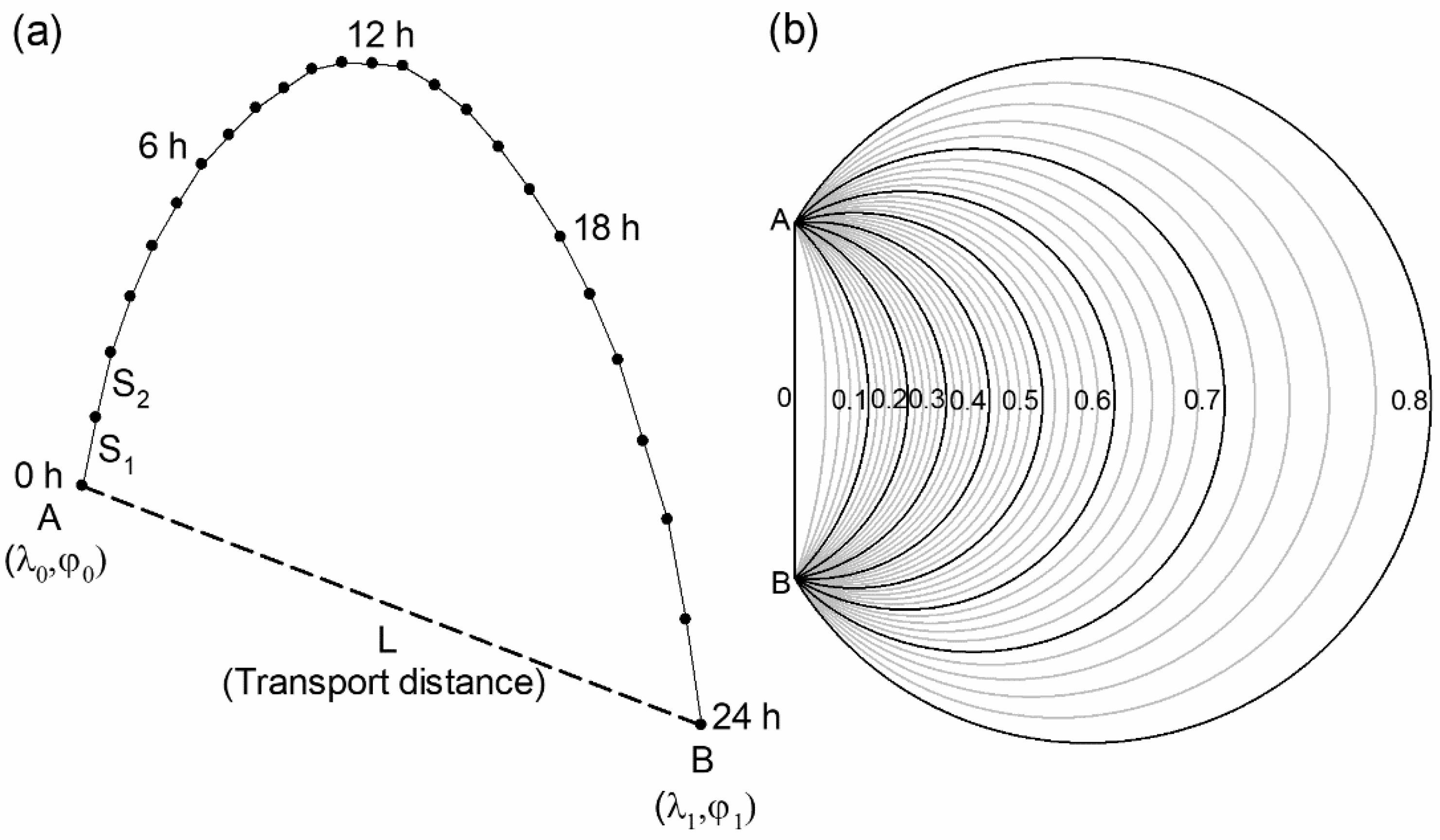
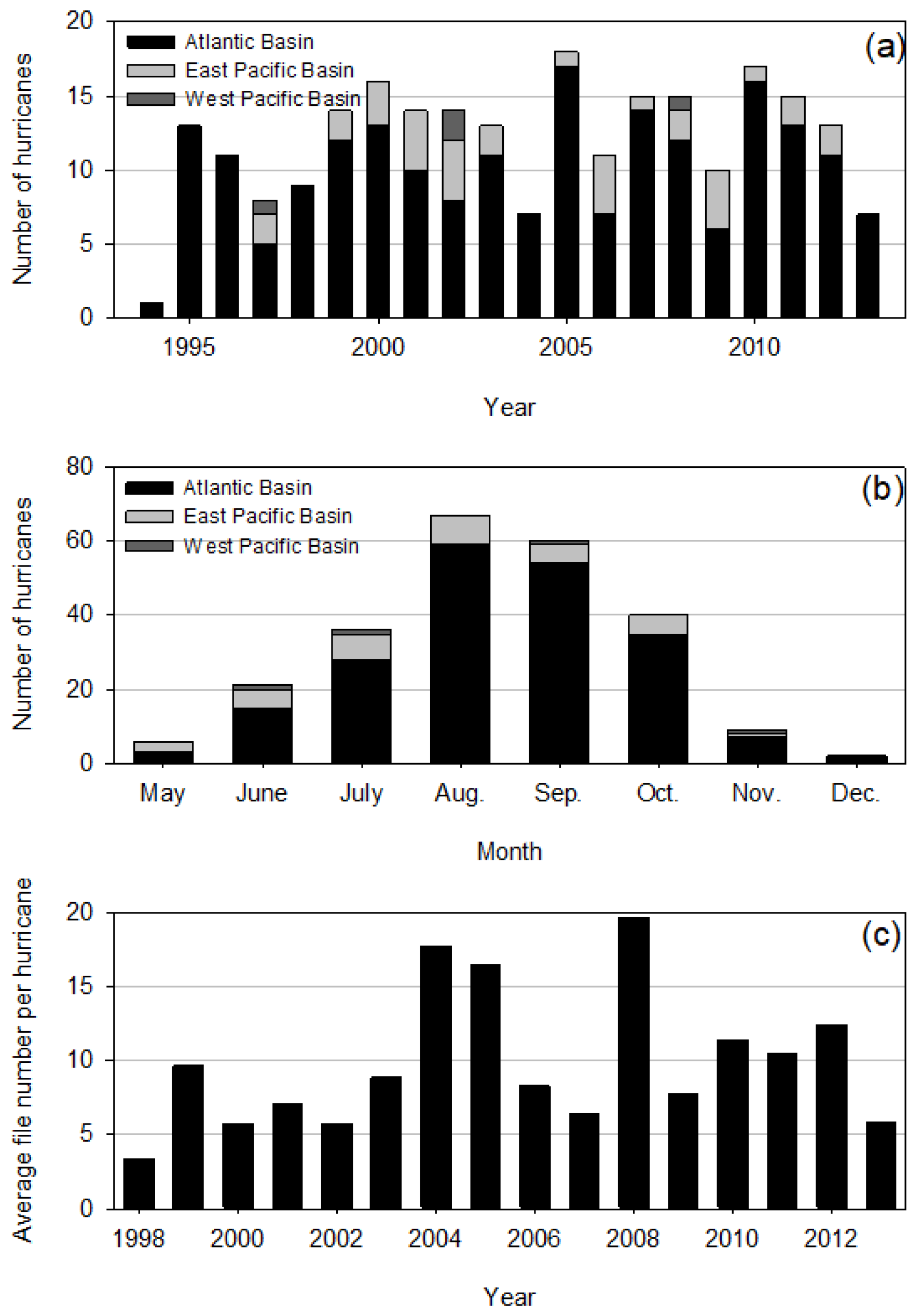
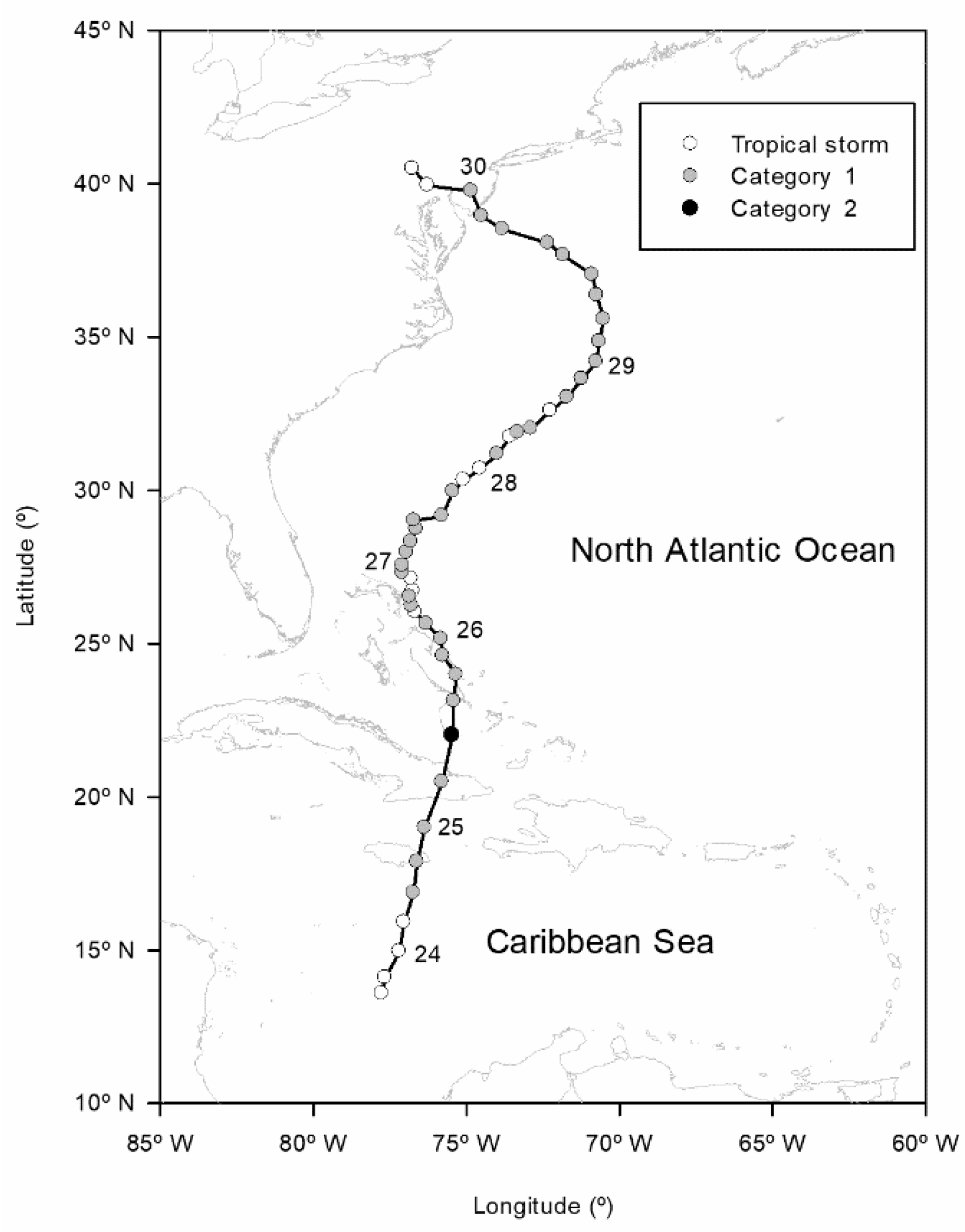
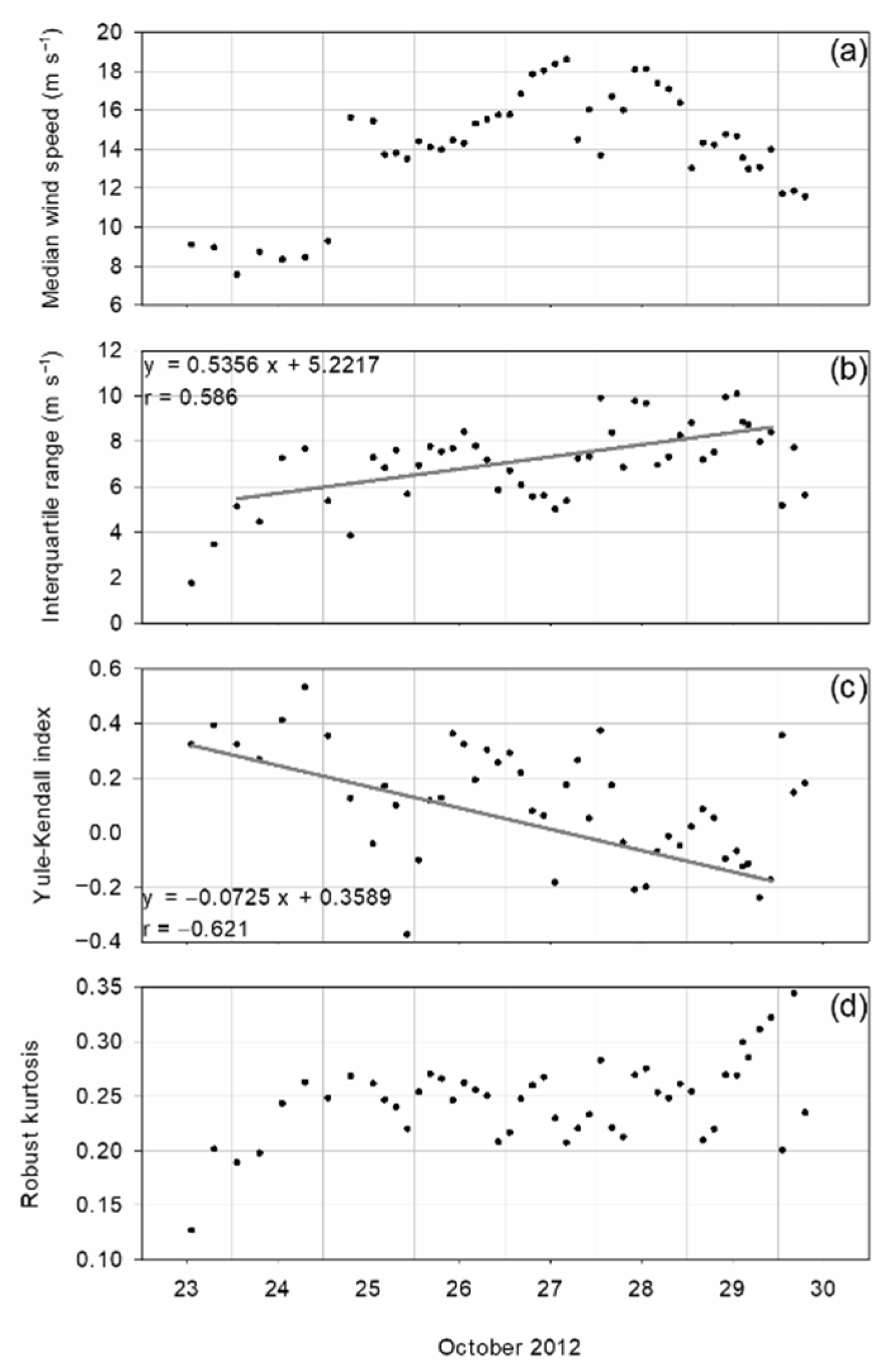
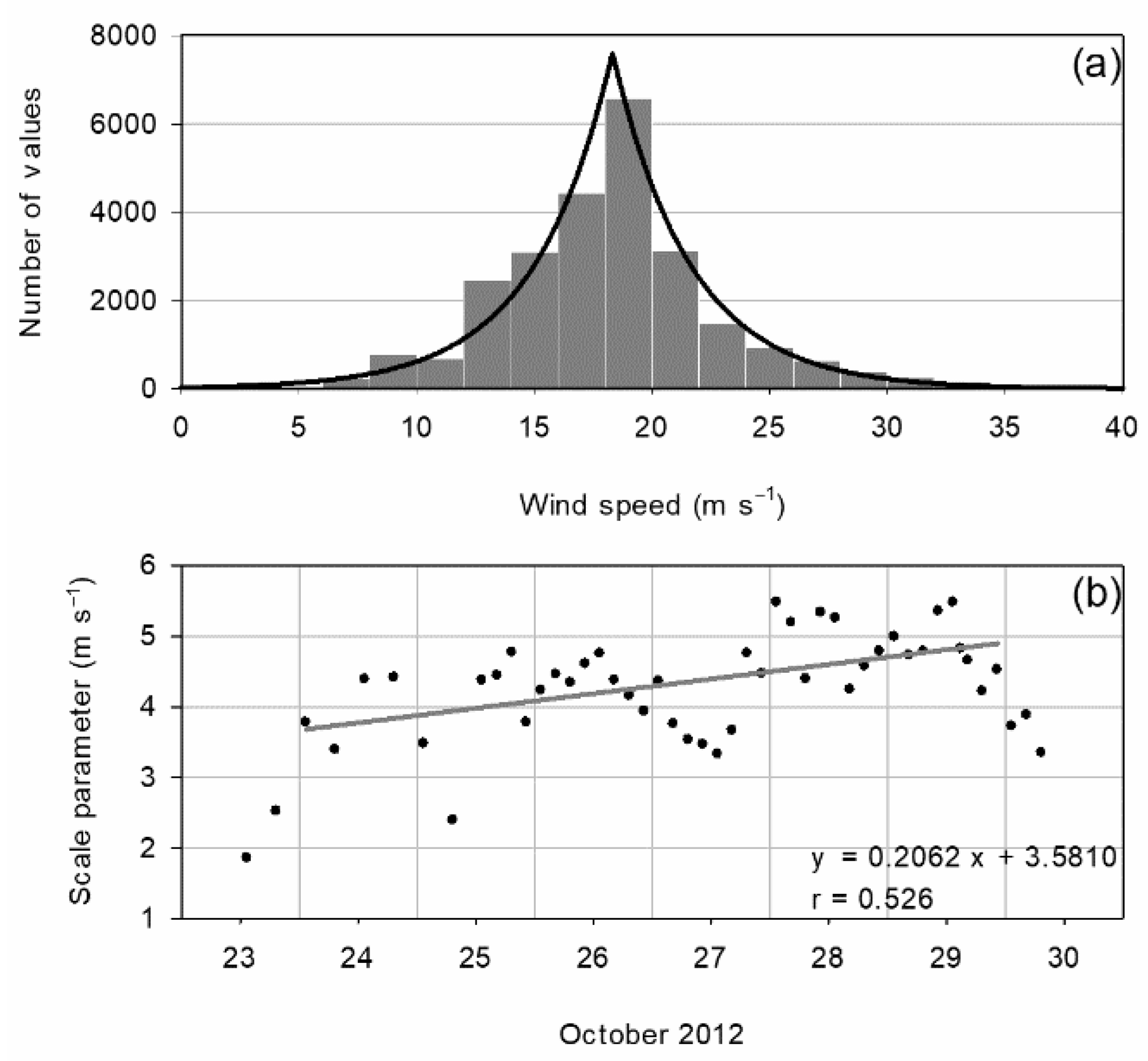
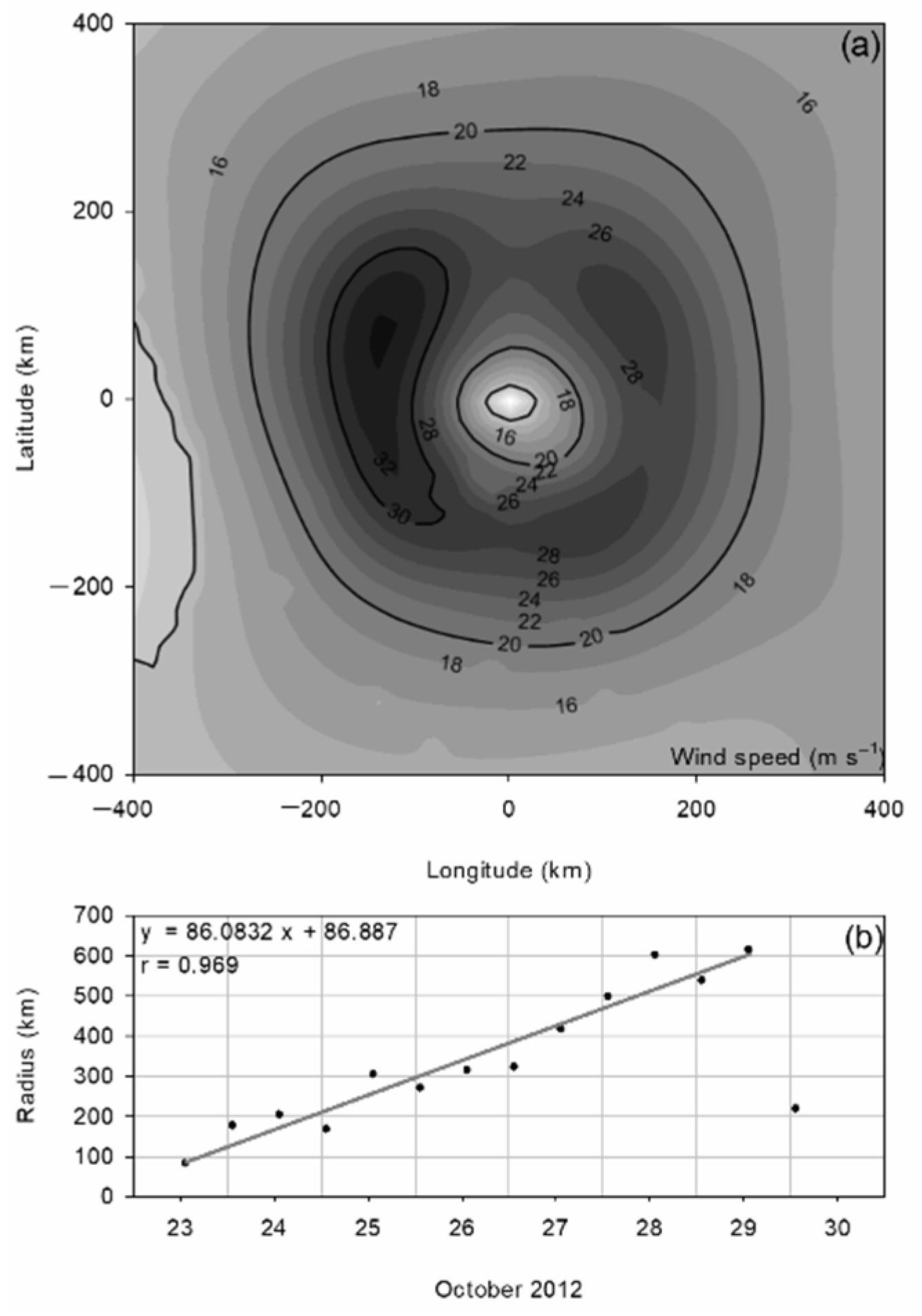
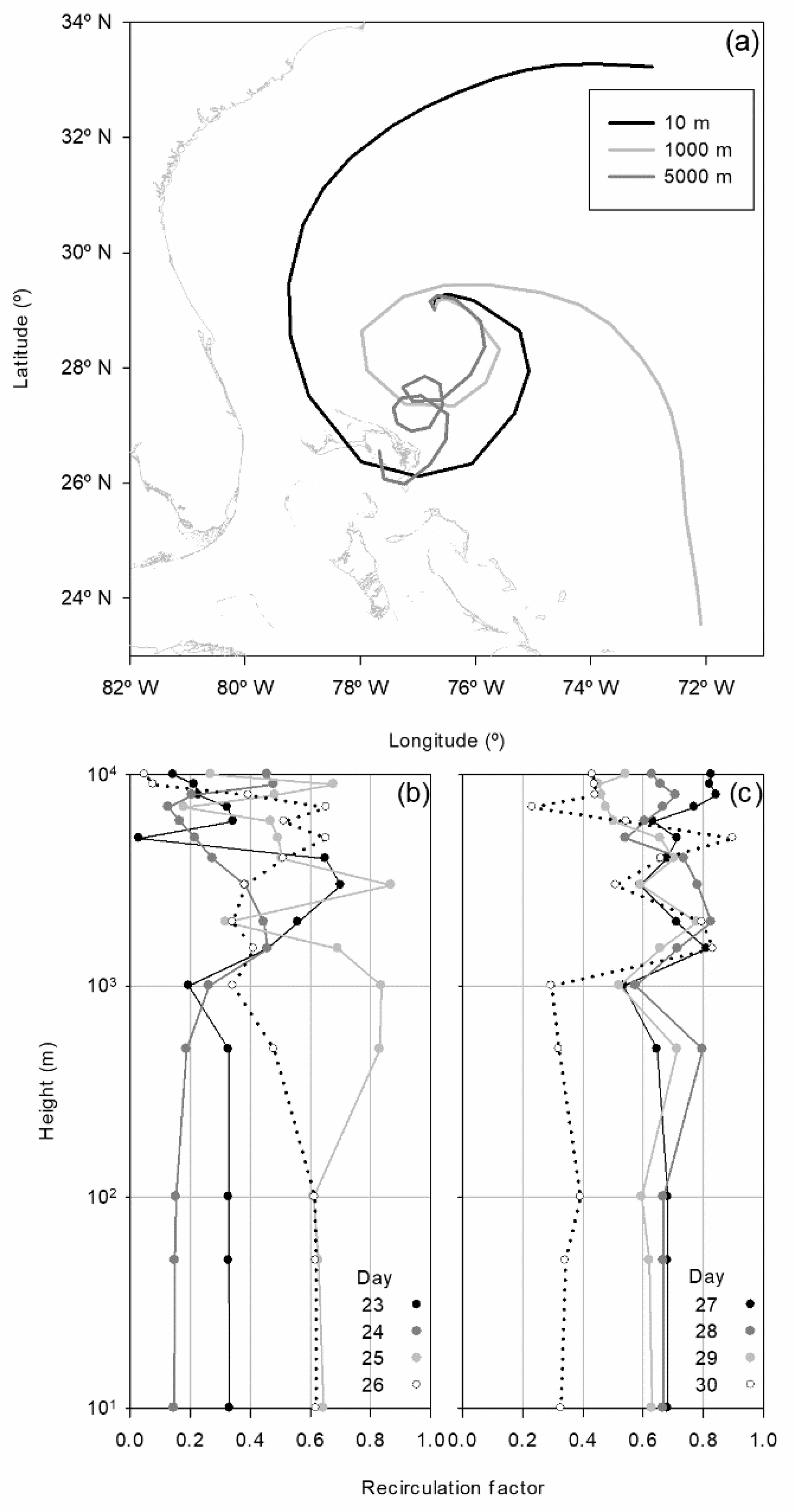
Publisher’s Note: MDPI stays neutral with regard to jurisdictional claims in published maps and institutional affiliations. |
© 2021 by the authors. Licensee MDPI, Basel, Switzerland. This article is an open access article distributed under the terms and conditions of the Creative Commons Attribution (CC BY) license (https://creativecommons.org/licenses/by/4.0/).
Share and Cite
Martínez, P.; Pérez, I.A.; Sánchez, M.L.; García, M.d.l.Á.; Pardo, N. Wind Speed Analysis of Hurricane Sandy. Atmosphere 2021, 12, 1480. https://doi.org/10.3390/atmos12111480
Martínez P, Pérez IA, Sánchez ML, García MdlÁ, Pardo N. Wind Speed Analysis of Hurricane Sandy. Atmosphere. 2021; 12(11):1480. https://doi.org/10.3390/atmos12111480
Chicago/Turabian StyleMartínez, Pablo, Isidro A. Pérez, María Luisa Sánchez, María de los Ángeles García, and Nuria Pardo. 2021. "Wind Speed Analysis of Hurricane Sandy" Atmosphere 12, no. 11: 1480. https://doi.org/10.3390/atmos12111480
APA StyleMartínez, P., Pérez, I. A., Sánchez, M. L., García, M. d. l. Á., & Pardo, N. (2021). Wind Speed Analysis of Hurricane Sandy. Atmosphere, 12(11), 1480. https://doi.org/10.3390/atmos12111480







